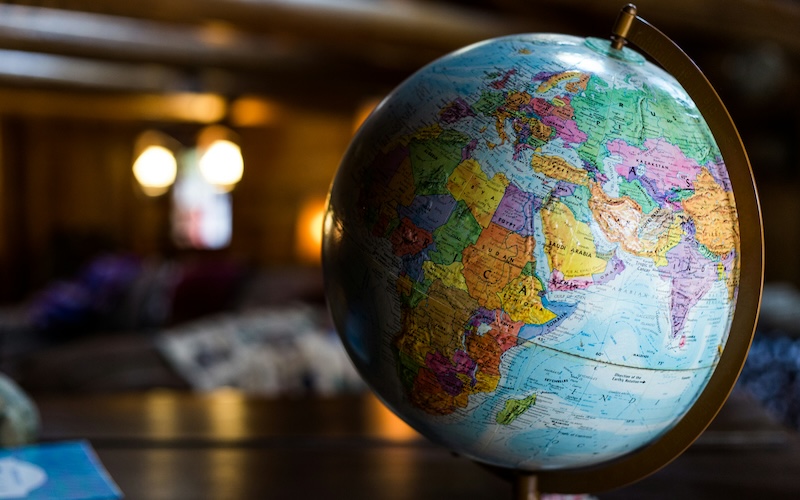Geographic segmentation: a guide for researchers and marketers

Geographic market segmentation helps marketers, data analysts, and researchers understand the differences between markets and the individuals in those markets. When they segment audiences by location, researchers can make more informed decisions and create more effective campaigns. They also gain valuable insights that would otherwise be lost if they treated everyone the same.
In this guide, we'll explain what geosegmentation is. You'll understand when and how to use this method, explore its benefits, and review real-world examples from well-known companies.
By the end of this guide, you'll have practical knowledge that you can apply to your research, marketing, and business strategies to reach the right audience in the right place. First, let's define geographical segmentation.
What is geographic segmentation?
Geographical segmentation definition: A method of segmenting markets or audiences by their location, such as countries, regions, cities, neighborhoods, or even climate zones. The underlying notion here is that people living in different places often have different needs, preferences, and behaviors. At the same time, people living in the same places are believed to share many common patterns.
To explain geographic segmentation in a business setting, let's assume an entrepreneur wants to launch a clothing line. Clients in cold regions may purchase winter clothes, while those in tropical areas may buy lighter clothes and outdoor products. The entrepreneur considers these differences and launches marketing campaigns and offers products accordingly to customers' needs. It's a fairly obvious geographic segmentation example, but a clear one.
Segmentation based on geography can enable you to carry out tailored research, offering products or services that better meet the needs of customers in different locations.
When you should segment by geography
Geographic segmentation makes the most sense when geography affects customer needs, wants, tastes, preferences, or behavior. You should use geographic segmentation for scenarios such as these:
- Regional differences: These refer to how people's responses to products, services, or messages differ across regions. For instance, a fast-food chain could market spicy menu items heavily in regions where customers have a penchant for bold flavors (South Asia or Latin America).
- Local trends or culture: Even within the same country, cultural habits, languages, or traditions can be different. A cosmetics brand may advertise skin care products differently in areas with higher sun exposure (for example, Southern California or parts of the Mediterranean) compared to regions with colder climates.
- Climate and weather patterns: Items in the clothing, food, or recreational product category could sell differently based on the climate. For example, winter coats sell more units in northern states, while beachwear items sell more units in coastal or tropical areas.
- Distribution and logistics: When data analysts and marketers understand where their customers are, it helps plan deliveries, identify store locations, or manage marketing campaigns. For example, an e-commerce business might offer faster shipping in urban areas and adjust its advertising for rural customers.
Geographic segmentation means dividing a market by where customers are located and helps specialists tailor marketing campaigns to local realities and improve decision-making.
Segmentation by location often appears in research approaches such as descriptive research, market analysis, and audience profiling, where the main goal is to understand how location impacts customer characteristics and behavior.
The benefits of geographic segmentation and the challenges
Segmentation by geography can help an organization learn how people in different locations may have different needs or preferences. It can make effective marketing and product decisions, yet it does come with several challenges that companies need to consider.
Benefits
- Better targeting. You can tailor products, messages, and campaigns to fit the needs of specific locations. Example of geographic segmentation: a chain of coffee stores may advertise cold beverages in areas with hot weather and hot drinks in cooler areas.
- Improved customer experience. When marketing and products are matched with the local context, customers feel understood.
- Efficient use of resources. Marketing budgets and distribution efforts are concentrated where they are most effective.
- Actionable insights. Using geographic segmentation, data analysts, marketers, and researchers can identify patterns and trends that vary by location. This helps specialists to make forecasts and plans.
Challenges
- Data availability. In some instances, it's difficult or expensive to collect detailed geographic data.
- Overgeneralizing. There are some risks of losing local nuance by grouping locations too broadly.
- Rapid change. Streamlined urban development, migration, or changing climate patterns can make previous geographic insights outdated, so keep your finger on the pulse.
- Integration with other segments. Geographic segmentation works best when combined with other data, such as demographics or behavior. However, a combination of different types of analysis can complicate the process.
By understanding both the advantages of geographic segmentation and the disadvantages, researchers and marketers can use geosegmentation wisely. As a result, they'll gain meaningful insights and create more effective strategies.
When specialists want to simplify the analysis of audience patterns and location-based insights without sacrificing depth, tools like Checkbox come to the service.
This survey software makes data collection easier, faster, and far more flexible. Request a demo to explore Checkbox's features!
Examples of geographic segmentation in research
Let's consider the main research contexts in which geographic segmentation can yield valuable insights:
- Academic research: Many universities and research institutes segment populations by region to study cultural differences, linguistic variation, migration patterns, educational outcomes, or community-level social behaviors. This segmentation helps specialists understand how geographic context influences human development, cognition, or societal trends.
- Public health research and epidemiological studies: Researchers compare health indicators across regions. They can identify the prevalence of chronic diseases, vaccination rates, or dietary patterns to understand disparities and offer solutions more effectively.
- Environmental and climate studies: Specialists analyze how climate change affects, identify pollution levels, or assess natural resource availability. Based on these findings, governments can plan strategies for risk mitigation.
- Socioeconomic and demographic research: Government agencies segment the population into regions or municipalities. The goal is to study income disparity, education access, housing conditions, or employment conditions.
- Urban planning and infrastructure analysis: Researchers assess the usage of transportation, land-use patterns, and measures of community development throughout neighborhoods or cities to guide policy decisions and future planning.
These geographic segmentation examples show us that this method allows researchers to collect precise, actionable data representative of real differences between locations, which leads to better decision-making rather than treating all customers or subjects identically.
Using a market research platform like Checkbox makes it easier to gather, analyze, and visualize these insights, such as regional preferences, local trends, and behavioral patterns. The use of this tool streamlines the process from survey creation to actionable results.
A list of common geographic segmentation variables
When segmenting the target groups by geography, researchers and marketers often consider a number of variables. These variables include the following:
All these variables enable businesses and researchers to implement focused strategies, ensuring that their products, campaigns, and analytics are relevant to people in every location.
To make it easier to collect geographic data, experts often use surveying tools and platforms. For instance, government survey solutions are applied where teams in the public sector have to collect location-based information and interpret it to plan policies or organize community programs. Similar survey tools find wide applications in different sectors like retail, healthcare, travel, and beyond.
Geographic segmentation in marketing
Segmentation by geography is powerful for marketers because it allows the tailoring of campaigns to the needs and preferences in specific locations. It finds application in the following ways:
- Targeted advertising: Advertising can be tailored according to cities, regions, or countries. For example, a sunscreen brand might focus digital ads on locations with the highest exposure to the sun.
- Localised promotions: Businesses can offer promotions that are relevant to local events, holidays, or weather. For instance, a coffee shop might promote cold drinks during a hot summer in a particular city.
- Product mix: They could stock up depending on regional preferences. Winter coats in northern states, light jackets in southern states.
- Store placement and expansion: The companies look at where demand is strong before opening new stores or new delivery hubs.
By means of geographic segmentation, marketers ensure that the right message reaches the right audience in the right place. Thereby, specialists can enhance engagement, sales, and customer satisfaction.
Companies that use geographic segmentation
Many renowned companies and brands like Coca-Cola, Amazon, and Nike apply geographic segmentation to their marketing and business strategy.
Coca-Cola
Large corporations like Coca-Cola generate a significant share of their revenues outside their home countries. According to Coca-Cola's Q4 and full-year 2024 report, a huge part of the company's net revenues comes from international markets. This makes having a global perspective and using geographic segmentation a vital part of marketing strategy today.
Coca-Cola constantly adapts its products, marketing, and distribution channels to specific regions to better connect with local consumers. It combines a global brand with regional strategies: beverage flavors, packaging, and advertising campaigns vary from country to country.
For example, in India, Coca-Cola localizes advertising, emphasizing family values and holidays like Diwali (a Hindu festival of lights).

In Latin America, the brand offers small packaging that is convenient for local stores and markets.
In Japan, Coca-Cola uses vending machines with a local product assortment.
The brand employs "hyper-localization" for content and packaging. This means design elements may be in local languages or culturally relevant in different countries.
Coca-Cola also collaborates with local brands, such as Inca Kola in Peru and Thums Up in India, to boost engagement and sales.
Amazon
This e-commerce giant uses geographic data to optimize shipping, recommend products, and run location-specific promotions.
Amazon uses geographic segmentation to tailor its strategies to regional differences in shopping behavior, preferences, and cultural norms.
What does this look like in practice? For example, Amazon has observed that sales peak at different times across regions. Peak shopping periods include Black Friday in North America, Boxing Day in the UK, and Singles Day in APAC. Amazon aligns product launches, pricing, advertising, and promotions accordingly to each period in each region.
Amazon is actively scaling its logistics. By the end of 2025, the company will expand Same-Day and Next-Day delivery to more than 4,000 small towns and rural communities, and is investing over $4 billion to triple the size of its delivery network by 2026.
AI helps Amazon analyze local demand and tailor product assortment to specific regions: products and inventory are distributed across cities and districts not uniformly, but according to the unique preferences of local shoppers.
Nike
Nike, the famous sportswear brand, creates market campaigns and launches its products based on regional trends and sports popularity in certain regions. For example, running shoes can be more effectively marketed in cities with running groups or communities. At the same time, football gear is targeted at countries and regions that are massively interested in football.
Nike's geographic segmentation helps to adapt campaigns to different regional preferences and market conditions. Products and marketing campaigns vary by region to reflect a local culture, climate, and sporting trend.
For example, in Europe and Latin America, more emphasis is placed on soccer products, whereas in the United States, a stronger emphasis is placed on basketball and American football.


Nike also tailors its retail strategies to match consumers' purchasing behaviors in urban versus rural areas. This brand opens stores in major cities and provides comprehensive online strategies reaching underserved regions.
All these three geographic market segmentation examples demonstrate that geosegmentation isn't purely about dividing markets by location. It's about understanding local needs and behaviors, and using those important insights to improve marketing strategies, boost sales, and improve customer satisfaction.
Final thoughts
Geosegmentation helps businesses, marketers, and researchers understand how people's needs, behaviors, and preferences change by location. In marketing, this method enables campaigns to be directed toward trends, culture, climate, and customer expectations of specific locales, making messages more relevant and effective.
In academic research, geographic market segmentation's definition is the identification of patterns, the testing of hypotheses, and the uncovering of differences across regions.
Combined with the right tools, geographic segmentation will help you make smarter, data-driven decisions.
Specialists often leverage enterprise feedback management (EFM) platforms, survey software, and other robust research tools like Checkbox to enable geographic segmentation. This software helps them to collect, organize, and analyze data efficiently, including geographic insights, across industries. Request a demo and start collecting insights with Checkbox!
Geographic segmentation FAQs

Demographic segmentation focuses on segmenting markets into categories based on age, gender, income, and education. Geographic segmentation definition: markets are divided according to where customers live, like countries, regions, or cities.

This method helps businesses and researchers to understand customer behaviors, preferences, and needs based on their locations. Geographic segmentation is about better targeting, customer satisfaction, and more efficient resource use.

Geographic segmentation enables experts to focus on appropriate campaigns, promotions, or products according to customers' locations. Using geosegmentation, marketers can be sure the messages will fit local tastes, culture, and even climatic conditions.


